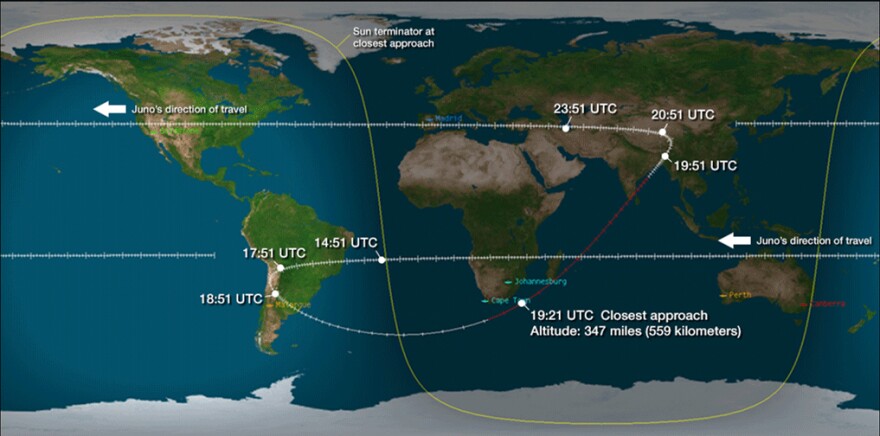After traveling for more than two years and some 1 billion miles, NASA's Juno mission to Jupiter is back where it started. Almost. At 3:21 p.m. ET Wednesday, the Juno space probe will be 347 miles away from Earth, just above the southern tip of Africa.
(As an aside, at around 11:30 a.m. ET, it was more than 90,000 miles away.)
It's not that Juno got homesick — the return to Earth was a necessity. To send it on a direct path to Jupiter would have required a more powerful rocket than the United Launch Alliance Atlas V-551. But that was the rocket that was available, so mission managers created a trajectory that uses Earth's gravity as a kind of slingshot, adding the oomph needed to set the spacecraft on course to its destination.
The Messenger spacecraft took a similarly circuitous route to reach Mercury's orbit, a journey that took nearly eight years. Check out this video of Messenger's path.
So will Juno be visible to people on Earth? According to the website Heavens-Above.com:
"If you know where to look and live in the right part of the world, you will have a chance to see it through binoculars or a telescope. Lucky observers who live in the extreme south-west of Africa (e.g. Cape Town) could even see it with the naked eye just before it enters the Earth's shadow."
Juno's primary mission is to measure the gravity and magnetic fields of the gas giant. The data should help scientists determine whether the planet has a solid core. It will be the first mission to fly low over Jupiter's poles. Actually, Juno will fly just below the planet's thin rings and just above the cloud tops.
But while it's still nearby, ham radio operators around the world have been invited to try a little experiment. Using Morse code, hams will send the message "hi" at frequencies in the 10 meter amateur band. The message will be sent very, very slowly. Each dot in the dot-and-dash code is supposed to last 30 seconds, so it will take 10 minutes to send the word "hi" once.
Why this little experiment? Well, largely it's to engage the public in a NASA mission. There is a scientific point, though. It will give Juno mission managers a chance to test out instruments designed to measure plasma and radio waves. A big goal of the Juno mission is to develop a better understanding of the auroras at Jupiter's poles.
It will take nearly three years for Juno to reach Jupiter once it leaves Earth. The expected arrival date is July 4, 2016.
Copyright 2021 NPR. To see more, visit https://www.npr.org.






